(and Astronomy) page 1
~ The Study of Threes ~
http://threesology.org
| Threes in Physics page 1 | Threes in Physics page 2 | 3 (mem)brane Universe page 1 | 3 (mem)brane Universe page 2 | 3 (mem)brane Universe page 3 |
Visitors as of 8/29/2020
Contents on this page:
- The Neutrino Matrix (Why are there 3 of everything?), by Jon Butterworth
- A Third type of Magnetism? (Atom can't tell up from down in 'quantum spin liquid'), by Richard Chirgwin
- NASA probes spots temporary third Van Allen radiation belt, by Iain Thomson
- C, P & T Symmetries (Wikipedia physics article)
Â
Why are there 3 of everything?
Last week's results from the Daya Bay neutrino experiment were the first real measurement of the third neutrino mixing angle, ?13 (theta one-three). There have been previous experiments which set limits on the angle, but this is the first time it has been shown to be significantly different from zero.
Since θ13 is a fundamental parameter in the Standard Model of particle physics1, this would be an important measurement anyway. But there's a bit more to it than that. Neutrinos - whatever else they might be doing - mix up amongst themselves as they travel through space. This is a quantum mechanical effect, and comes from the fact that there are two ways of defining the three types of neutrino.
You can define them by the way they are produced. So a neutrino which is produced (or destroyed) in conjunction with an electron is an "electron neutrino". If a muon is involved, it's a "muon neutrino". The third one is a "tau neutrino". We call this the "flavour". Or you can define them by their masses. Usually we just call this definition neutrinos 1, 2 and 3.
The two definitions don't line up, and there is a matrix which tells you how much of each "flavour" neutrino overlaps with each "mass" one. This is the neutrino mixing matrix. Inside this matrix in the standard model there are potentially four parameters describing how the neutrinos mix.
You could just have two-way mixing. For example, the flavour states might just mix up neutrino 1 and 2, and neutrino 2 and 3. This would be the case if the angle ?13 were zero. If it is bigger than zero (as Daya Bay have now shown) then neutrino 1 also mixes with neutrino 3. In this case, and only in this case, a fourth parameter is also allowed in the matrix. This fourth parameter (d) is one we haven't measured yet, but now we know it is there. And the really important thing is, if it is there, and also not zero, then it introduces an asymmetry between matter and Antimatter.
This is important because currently we don't know why there is more matter than Antimatter around. We also don't know why there are three copies of neutrinos (and indeed of each class of fundamental particle). But we know that three copies is minimum number which allows some difference in the way matter and Antimatter experience the weak nuclear force. This is the kind of clue which sets off big klaxons in the minds of physicists: New physics hiding somewhere here! It strongly suggests that these two not-understood facts are connected by some bigger, better theory than the one we have.
We've already measured a matter-Antimatter difference for quarks; a non-zero ?13 means there can be a difference for neutrinos too. More clues.
So not only did last week see the start of Antimatter spectroscopy (which will check that there really is no matter-Antimatter asymmetry in the electromagnetic force), it also saw the result which shows that experiments such as T2K in Japan and Nova in the US, which are looking for matter-Antimatter asymmetry in the weak force, amongst neutrinos, are not wasting their time.
Unlike the ALPHA anti-hydrogen experiment at CERN, the Daya Bay people have put their result somewhere you can actually read it - thanks.
1 The "new" standard model, i.e. the one with massive neutrinos.
2 These choices of definition are called "eigen-states"; they are essentially different measurements of the neutrino wave-function. So you might in principle measure a neutrino such that you know it is 1,2 or 3, but then you don't know what flavour it is until you measure that (similar to not knowing whether Schrödinger's cat is alive or dead until you open the box). And once you've done that, you no longer know its mass. Quantum mechanics is great.
Jon Butterworth is a physics professor at University College London. He is a member of the High Energy Physics group on the Atlas experiment at Cern's Large Hadron Collider.
http://www.guardian.co.uk/science/life-and-physics/2012/mar/13/1
  Â
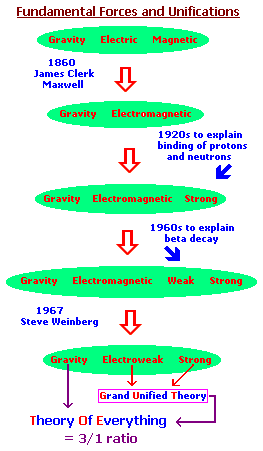 Â Â Â Â Â
    Â
(H.O.B. Note, 12 Oct. 2012): In spite of all the "threes" being encountered in physics, the basics of which involve threes as well: 3 families of fundamental particles and 3 basic particles ... Electrons, Neutrons, Protons... we must consider the possibility that our physics is due to our 3-patterned physiology evolving on a 3rd planet. While we might want to argue that our theoretical suppositions are correct and have a mathematics to confirm them, let us also consider the very real possibility that our mathematical algorithms are being used as a simplistic 3-patterned tool (1 number [plus, minus, divided or multiplied by] a 2nd number = 3rd number); that is manipulated to confirm ideas influenced by this 3-patterned physiology. It will be necessary for us to confirm our guesstimations/confirmations by deliberately subjecting our "evolvable"- sensitive biology to environments that are not so 3's "oriented". (To the extent of directing biological development along what appears to be three-"pronged.") Indeed, even our very DNA/RNA- Protein triplet structures (they are actually three-to-one ratios), may have to be altered to develop a different sentient species' with a perspective that we might find quite alien...
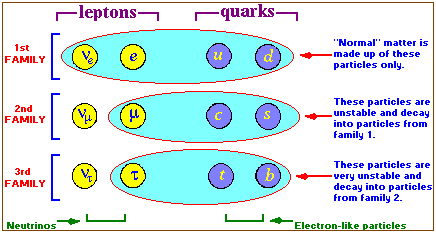
Are there really three families of fundamental particles or do we only think there are and qualify our usage by saying such a model (framework) is of value because it helps us to relevantly compartmentalize available assumptions? Simplistically, the three families are:
- Stable particles (in terms we humans recognize stability).
- Unstable Particles (which 'decay' to stable particles).
- Very Unstable Particles (which 'decay') to unstable particles.
Are there really three domains of life: "Archaea, Bacteria, Eukaryota," or is this evolutionary framework suggestive of a widespread "three-patterned" mode of rationalization we humans use in many subject areas?
Are there really three gut types: bacteroides, prevotella and ruminococcus - (named for the bacteria that dominate the intestines in each case), or are we limited in our ability to detect others because we use a standard three-patterned scientific investigative model (framework) [observation, experiment, hypothesis]... which limits our ability towards appreciating a different perspective; whether or not we socially acknowledge that we do use a scientific-community-standardization (or that our findings explicitly state the particular order the methodological steps undertaken)?
For the philosophical-religious minded: does the Christian Trinity of Father - Son - Holy Ghost/Spirit really exist, or do you only think it does, because your brain is three-patterned configured (to a different degree) like that of someone with a three-patterned scientific orientation (mindset)? Are there really three functions of the Cosmos (Creation, Maintenance, Destruction... personified by Brahman - Vishnu - Shiva) as are portrayed in Hinduism, or is this yet another human colored portrait of an underlying three-patterned physiology? Are the pattern-of-three ideas we find in multiple subject areas due to a tri-modal language structure (Subject - Object - Verb) due to a three-patterned ear/auditory structure?
 Â
What if we are not on the 3rd planet from a source of solar irradiation but think that we are because it fits best with our ability to comprehend a perspective more conducive to a 3-based physiology? As an analogy, recall that centuries ago it was firmly believed that the Earth was the center of the then known cosmos but that a three-patterned based mathematics dispelled this perspective. We must consider the possibility, no matter how we dogmatically (god-matically) uphold a religious-like fervor of present mathematics tools,  that we might well be wrong.
In taking stock of the very many examples of "threes" to be found in numerous subject areas, let me take a moment to make a comment about this:
The various manifested expressions of the "3" in our philosophies, religions, sciences and biology (and physiology), are extensions of environmental influences that force us to design our beliefs and laws in step with the prevailing nature of its character. As it changes, so will our presumed truths. Humanity must get away from Earth, this solar system, and this galaxy in order to begin its individualized ("weaned") journey of growth.
ÂÂ Â
Some readers may also be interested in:
Atom can't tell up from down in 'quantum spin liquid'
  Â
→Get more from this author←
Posted in →Science← 21st December 2012 09:47 GMT
A state of magnetism predicted in 1987 has been observed for the first time at MIT, with researchers saying that it might one day find applications in storage and communications technologies.
The “one day†is still quite some way off, however, with the researchers only at the very beginning of observing the properties of what’s called a “quantum spin liquid†(QSL).
The properties of a quantum spin liquid are revealed in the spin properties of atoms in a crystal. Rather than settling into a stable state, as happens in ferromagnetic and antiferromagnetic materials, the “spin moment†in a QSL is constantly changing.
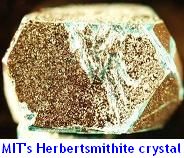
In the familiar compass needle, magnetism comes from the alignment of all spins in the same direction. The second magnetic state, antiferromagnetism, was first proposed in the 1930s. In an antiferromagnetic material, the spin states align in such a way that the overall magnetism is zero, unless energy is applied. This property is exploited in hard drive read heads.
In the new state of magnetism, the magnetic orientation of particles is unable to settle into an ordered state. Instead, they fluctuate constantly, driven by quantum interactions between particles.
QSL only exists in a type of crystal called a kagome lattice. In the material examined in the MIT research, Herbertsmithite (named after its discoverer):
Copper atoms lie at the corners of triangular structures.
Two of the copper atoms are able to align their spins in an “up-down†arrangement.
But the third copper atom can’t align with both the others, so it flips between up and down.
(The usage of an "H" symbol seems appropriate even though you may visually entertain an "I" or other symbology.)
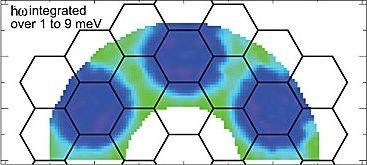
The blue regions in the NIST scan of Herbertsmithite show magnetically ordered regions. The green regions are exciting: they're where the spin state is disordered. Image: NIST
To actually observe the QSL, the researchers spent years manufacturing high-purity Herbertsmithite. The test sample was then imaged using the Multi-Axis Crystal Spetrometer (MACS) at the NIST Center for Neutron Research.
In a disordered material, neutrons scatter evenly across the sample. In the QSL sample, some regions scatter neutrons in a way consistent with magnetism – but in other regions the scattering appears disordered (those regions where the atom’s spin fails to settle down).
Wait, there’s more
Along the way, the researchers made another possible discovery as significant as the QSL: they believe they’ve observed fractionalised quantum states.
Quantum states are generally assumed to exist only as whole numbers – after all, the basis of quantum physics is that the quantum is the smallest possible change in state that can exist.
The MIT researchers say that their material exhibits a state with fractionalised excitations: “spinons†whose excited states apparently exist in a continuum between quantum states. In the MIT →release←, the researches say observing this “highly controversial idea†is “a remarkable firstâ€.
The research, conducted by professor Young Lee, Tianheng Han (lead author of the paper), and collaborators from MIT, NIST, Maryland University and Johns Hopkins University, is published in Nature (abstract →here←).®
Â
By → Iain Thomson ← in San Francisco
→Get more from this author←
Posted in Science, 1st March 2013 08:11 GMT
This'll drive the lunar deniers crazy
For over fifty years school-books have been teaching about the Van Allen belts, two torus-shaped zones of charged particles that encircle the Earth. Now, a NASA mission has discovered that there is a third – but only when conditions are right.
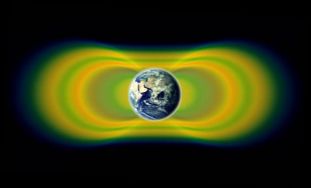
Last August, NASA fired a pair of Radiation Belt Storm Probes (RBSP) into the belts to do the most detailed study yet of their composition. The spacecraft, heavily shielded to function in the plasma belts, were scheduled to start booting up their equipment in slow and steady progression – witness how long Curiosity was on the Surface of Mars before all her systems were used.
But the team decided to turn on the Relativistic Electron Proton Telescope (REPT) early, three days into the flight, so that it could match data with another NASA probe – the Solar, Anomalous, and Magnetospheric Particle Explorer (SAMPEX) which was falling back towards Earth. When the data came in, the third belt was revealed.
"By the fifth day REPT was on, we could plot out our observations and watch the formation of a third radiation belt," said Shri Kanekal, the deputy mission scientist for the probes at NASA's Goddard Space Flight Center."
"We started wondering if there was something wrong with our instruments. We checked everything, but there was nothing wrong with them. The third belt persisted beautifully, day after day, week after week, for four weeks."
While it is known that the inner Van Allen belt swells slightly, and the outer one more massively, this third ring is a surprise. Then again, scientists still aren't 100 per cent sure what makes the rings grow and shrink anyway, since their size is only partially attributable to the Sun's output.
In a paper in the journal Science, the team postulates that part of the expansion of the Van Allen belts is down to a solar flare that erupted from Sol's surface on August 31, the day after the launch. The filament of plasma, which was spotted by NASA's Solar Dynamics Observatory, sent a stream of particles and a shock wave towards Earth, and this may have energized the third layer.
"We can offer these new observations to the theorists who model what's going on in the belts," said Kanekal. "Nature presents us with this event – it's there, it's a fact, you can't argue with it – and now we have to explain why it's the case. Why did the third belt persist for four weeks? Why does it change? All of this information teaches us more about space."
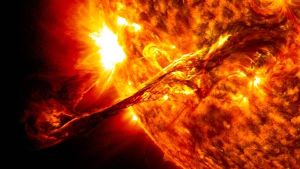
This flare may have kicked off the extra belt:
The belts were discovered when the US lofted its first satellite, Explorer 1, back in 1958, and were named after the scientist James Van Allen who built the cosmic ray detector that picked them up. Van Allen was one of the very first space scientists, and made some of the early measurements of the upper atmosphere in 1946 using captured German V-2 rockets.
Van Allen grew more and more fascinated with the research, and developed innovative ways to carry it on. He is the co-creator of the Rockoon, an early solid-state rocket that was hoisted to 70,000 feet by a helium balloon and then fired automatically by a clockwork control system. Rockoons are still used today, not least by El Reg's Special Projects Bureau's team to send LOHAN thrusting into the sky.
The belts that bear his name are a problem in more ways than one. They increase the failure rate for satellites and probes that go through them, as well as harming astronauts. Van Allen himself said that the presence of the belts, and the myriad of other things that can go wrong on a manned space flight, should stop humans leaving orbit.
"In a dispassionate comparison of the relative values of human and robotic spaceflight, the only surviving motivation for continuing human spaceflight is the ideology of adventure," he said.
"At the end of the day, I ask myself whether the huge national commitment of technical talent to human spaceflight and the ever-present potential for the loss of precious human life are really justifiable."
Such comments have been picked apart (and occasionally shuffled around) to help reinforce one of the central tenets of the "We never went to the Moon" movement: that humans couldn't possibly make it through the belts alive. This latest discovery, that they could be more extensive than first thought, could add fuel for the fool's fire.
Van Allen himself rubbished such claims, pointing out that at the speed the astronauts were going they went through the belts in four hours and received no more radiation than they would living at sea level for three years.
In fact, the Van Allen belts actually confirm we did make it out of Earth's orbit. All but three of the Apollo astronauts who went out to the Moon have since developed cataracts earlier than expected as a result of their exposure to cosmic rays.
Still, when have deniers ever let science get in the way of a good conspiracy theory?®
H.O.B. note: In considering the foregoing article we need to ponder whether or not a third Van Allen belt actually is atypical, or is as such from our human perspective due to a short term of analyzing the belts (since they were "discovered")? Does it exist on a frequent basis and it is only our primitive forms of analysis that have been unable to detect it until now? Is it somehow different than the other two? Has it "always" (centuries, millennium, eons) been there but only "recently" (in terms of human evolution) that we were able to recognize it? Are the "right conditions" for producing the 3rd belt cyclical in their nature? If so, what is the cycle? Why is it (the 3rd belt) or/and the conditions cyclical? If the condition(s) are not cyclical, is the event one of several which mark a "developmental" (burnout change/rate) in the Sun?
H.O.B. note: The flare gave me the impression of a reptile with an elongated tongue lashing out at its prey. Perhaps the "prey" of the Sun are the nearby planets which can help nourish its existence? Also, I humorously made a mental scribbling of "Van Allen" as "Van Alien"... with no disrespect intended.
Science Shot:
by Lizzie Wade
9 May 2013, 2:00 PM
--- The Life Cycle of a Bubble ---
Another day, another ground-breaking physics experiment about --- bubbles ---. Although scientists have long understood the behavior of a single soap bubble, they have not been able to mathematically describe the behavior of clusters of bubbles, otherwise known as foams. As you can see in the photo above, when one bubble pops in a group like this, the other bubbles quickly rearrange themselves to balance out the cluster—but because the forces behind all that shape-shifting are different from the forces determining when each bubble pops, it's difficult to make a computer model that can incorporate all phases of a foam's life. Now, scientists have solved the problem by taking a hint from climate models, which have long struggled to figure out how local events (a volcanic eruption in Hawaii or a single bubble in a foam popping) influence more widespread changes (global temperature changes or the foam entirely collapsing).
The new model --- splits up a foam's life into three phases ---, the researchers report online today in Science: rearrangement, in which the group of bubbles slip and slide around each other to achieve stability; drainage, in which gravity draws the fluid inside a bubble's membrane toward the earth; and rupture, in which a bubble's membrane becomes so uneven that it finally pops, forcing the remaining bubbles to rearrange themselves and allowing the cycle to begin again. While the researchers tested their model using—you guessed it—soap bubbles, they hope their work will help materials scientists better understand and control the properties of solidified foams made of metal and plastic, which are vital for applications that require materials that are both light and strong—like prosthetic limbs.
©2013 American Association for the Advancement of Science. All Rights Reserved.
H.O.B. note: As I recall, there were three "famous" recurring bubble events of childhood:
- Bubble Baths (But I don't remember ever having one. In fact, I hated taking baths.)
- Blowing/making bubbles (with a straw in a beverage, monster bubbles, or the variety which are made by using what looks like a monocle-on-a-stick (or an ankh without the arms).
- Bubbles surfacing on some liquid such as a pond, river, or curb-side "river" after a rain storm. (That the kids in the neighborhood would try to dam up, float a "boat" on, or walk in with our bare feet.)
The Standard model of particle physics has three related natural near-symmetries. These state that the actual universe about us is indistinguishable from one where:
-Every particle is replaced with its antiparticle. This is C-symmetry (charge symmetry).
-Everything appears as if reflected in a mirror. This is P-symmetry (parity symmetry).
-The direction of time is reversed. This is T-symmetry (time symmetry).
These symmetries are near-symmetries because each is broken in the present-day universe. However, the Standard Model predicts that the combination of the three (that is, the simultaneous application of all three transformations) must be a symmetry, called CPT symmetry. CP violation, the violation of the combination of C- and P-symmetry, is necessary for the presence of significant amounts of baryonic matter in the universe. CP violation is a fruitful area of current research in particle physics.
   Â
Date of Origination: Thursday, May 2nd, 2019... 7:58 AM
Most recent update: Tuesday, March 30th, 2021... 1:30 PM
Herb O. Buckland
herbobuckland@hotmail.com